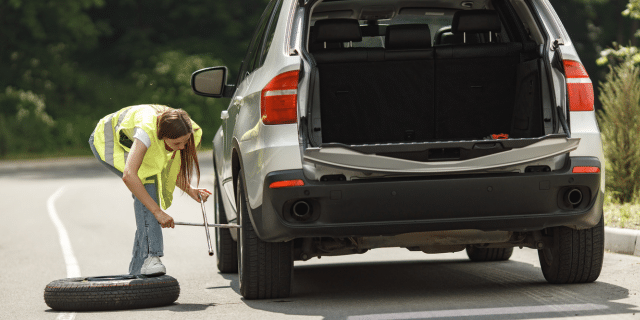
by California Casualty | Pets, Safety |
Summer is here, and our four-legged friends are ready to make the most of it—soaking up the sun, chasing butterflies, and joining us for backyard barbecues and beach days. But while the season is packed with tail-wagging fun, it also brings a few hidden hazards that can sneak up on even the most watchful pet parents. From sizzling sidewalks to tempting picnic snacks, summertime can be trickier than it looks. Here’s how to keep your fur babies safe, healthy, and ready for all the warm-weather adventures ahead!
Barbecues, Picnics, and Parties
Nothing says summer like a backyard cookout—but it’s not always a pet-friendly affair. Popular BBQ foods like rib bones, corn on the cob, and watermelon rinds may seem harmless but can cause serious health issues, including choking and intestinal blockages. Onions, grapes, and alcohol are outright toxic to pets, and treats like ice cream and potato salad can upset sensitive stomachs. Also be mindful of wooden skewers and toothpicks, which can splinter and cause internal injuries if chewed or swallowed.
Remind your guests not to share their food with your pet. Instead offer pet-safe treats as an alternative. Supervise your furry friend closely, especially if they’re known for getting into mischief—or are particularly sociable.
Lawn and Pool Chemicals
Beautiful lawns and sparkling pools can hide serious dangers. Fertilizers, pesticides, and pool chemicals are harmful if ingested, inhaled, or absorbed through your pet’s paws. Always store chemicals securely, clean up spills right away, and keep pets off freshly treated grass. When possible, choose pet-safe products that reduce the risk while still maintaining your outdoor space.
Dangerous Plants
Gardening this summer? Be sure your landscaping isn’t a hidden health hazard. Azaleas, lilies, rhododendrons, tulips, and daffodils are just a few of the plants that can be toxic to pets. Ingesting them can lead to vomiting, seizures, heart issues, and even death. Before heading out on a walk or letting your pet explore the garden, brush up on which plants are safe. (Check out our pets and plants blog for a detailed guide.)
Itchy and Stinging Insects
Summer means bugs—and lots of them. Fleas, ticks, and mosquitos can make your pet miserable and may carry dangerous diseases like heartworm and Lyme disease. Bees, wasps, and fire ants also pose risks, especially to curious pets who like to sniff and paw at anything that moves.
To protect your pet:
- Use flea, tick, and heartworm preventatives
- Check daily for ticks, especially after walks in wooded or grassy areas.
- Eliminate standing water and trim overgrown plants to deter pests.
- Monitor your pet for signs of bites or stings, such as swelling, excessive scratching, or difficulty breathing. In the case of a severe allergic reaction, seek veterinary help immediately.
Heat and Humidity
High temperatures and humidity can quickly lead to heat exhaustion or heatstroke, especially for older pets, overweight pets, or breeds with short snouts like pugs and bulldogs. Signs of heatstroke include excessive panting, drooling, and dry gums (a sign of dehydration). Your pet also may appear lethargic.
Always provide shade and fresh water and avoid intense activity during the hottest parts of the day. Never leave your pet in a parked car—not even for a few minutes. On a 75-degree day, the temperature inside a vehicle can soar to 100 degrees in just 30 minutes.
Also, be cautious of hot pavement and sand. Use the hand test: place your hand on the sidewalk for seven seconds. If it’s too hot for your hand, it’s too hot for paws. And don’t forget about sunburn! Pets can get burned too—especially on ears, noses, and bellies. Use pet-safe sunscreen, never human sunscreen, to protect exposed areas.
The Beach and the Pool
Many dogs love the beach, but it can come with unexpected dangers. Hot sand can burn sensitive paw pads, and ingesting sand can lead to a dangerous bowel obstruction. Sand can also irritate your pet’s eyes if it gets lodged under their eyelids.
As for water safety, not all dogs are natural swimmers. Never force your pet into the water, and always use a pet lifejacket, especially if you’re on a boat or near deep water. After a swim, rinse your dog off to remove salt or chlorine.
Fireworks and Thunderstorms
The loud booms of summer storms and fireworks can terrify pets, causing stress, anxiety, or even escape attempts. Prepare a safe, quiet space indoors where your pet can retreat. You can also try anxiety wraps, pet pheromone sprays, and soft music or white noise. For severe anxiety, talk to your vet about possible calming medications. And always secure doors, gates, and windows in case your pet tries to bolt.
Traveling with Your Pet
Planning a road trip with your fur baby? Keep your pet secured in a well-ventilated carrier or use a pet seatbelt harness. Never leave them unattended in a parked vehicle. Bring along water, treats, and poop bags, and schedule regular breaks.
Make sure your pet is microchipped and wearing ID tags with up-to-date contact info—just in case you get separated. If you’re flying, be sure to review your airline’s pet policy or check out our blog on flying with pets for extra tips.
One More Layer of Protection
We love our pets and no matter how careful we are, accidents happen. Pet insurance can offer peace of mind, helping cover unexpected vet bills so you can focus on keeping your pet happy and healthy all summer long.
This article is furnished by California Casualty, providing auto and home insurance to educators, law enforcement officers, firefighters, and nurses. Get a quote at 1.866.704.8614 or www.calcas.com.

by California Casualty | Auto Insurance Info |
The freedom of summer is calling, and for many teens, that means hitting the road—often for the first time without a parent in the passenger seat. With new jobs, beach days, late-night hangouts, and spontaneous road trips on the agenda, it’s easy to forget that driving comes with serious responsibility. For parents, this season is a crucial time to set clear expectations behind the wheel. From curfews to passengers to phone use, establishing ground rules now can help your teen build smart habits that last far beyond the summer.
Follow intermediate licensing laws in your state.
Most states have graduated driver licensing (GDL) programs designed to help teens gain experience behind the wheel while minimizing risks. These often include rules like curfews, limits on passengers, and restrictions on highway driving. Start by familiarizing yourself with your state’s laws at www.ghsa.org. Then, build on those requirements with your own family rules. For instance, you might allow only daylight driving for the first month, then gradually expand driving privileges as your teen demonstrates responsibility.
Establish a nighttime curfew.
Driving at night is inherently more dangerous due to decreased visibility and increased likelihood of encountering impaired drivers. Teens, who are still developing experience and judgment, are especially vulnerable. Even if your state allows nighttime driving, consider setting a curfew that keeps your teen off the road during high-risk hours—often between 9 p.m. and 6 a.m. You might also require that they log a certain number of supervised nighttime hours with you before being allowed to drive alone after dark.
Ban cell phone use while driving.
Distracted driving is a leading cause of accidents, and teens are especially susceptible. While some states ban any cell phone use for drivers under 18, it’s smart to create a zero-tolerance rule at home regardless of local laws. That means no texting, no scrolling, and ideally, no hands-free calls unless absolutely necessary. Consider installing monitoring apps that block texts and calls while driving, and most importantly, model good behavior yourself—your teen is watching.
Talk about speeding—and how to avoid it.
Speeding contributes to nearly a third of all fatal teen crashes. Stress the importance of following posted speed limits, adjusting for weather conditions, and maintaining safe following distances. Teach your teen the three-second rule for following other vehicles, and how to give extra space to large trucks. Encourage them to build in extra time when leaving for work or social plans so they’re never tempted to rush.
Enforce seat belt use—every ride, every time.
Seat belts save lives, plain and simple. Make it a non-negotiable rule: the car doesn’t move until everyone is buckled up. Remind your teen that they are responsible for their passengers’ safety, too. Unbelted passengers can become deadly projectiles in a crash—even in the back seat.
Address impaired driving before it happens.
Teens may face peer pressure to drink or ride with someone who’s been drinking. It’s essential to talk openly about these situations and offer a safe exit plan. Let your teen know they can always call you for a ride—no questions asked—if they’re ever in an unsafe situation. Emphasize that driving under the influence of any substance, including marijuana or even some medications, is never acceptable.
Being a safe driver also means being prepared. Make sure your teen knows how to check the gas gauge and fill up when needed—ideally before it dips below a quarter tank. Show them how to recognize warning lights, check tire pressure, and know what to do in case of a breakdown. A quick review of the vehicle’s manual can go a long way in empowering your teen behind the wheel.
Know your teen’s driving plans.
As your teen begins driving independently, stay in the loop. Ask them to let you know where they’re going, who they’ll be with, and when they plan to return. If plans change, they should update you before getting behind the wheel again. Keeping control of the car keys is one way to ensure that you stay informed.
Put it in writing.
Consider drafting a parent-teen driving agreement that outlines the rules and consequences clearly. This written commitment can serve as a helpful reminder and a great conversation starter. It also opens the door for regular check-ins to reassess the rules as your teen gains experience. Be sure to revisit the agreement periodically, especially if any violations or concerns arise.
Don’t forget the insurance.
Before your teen starts driving, make sure they are properly insured. In some cases, good student discounts and safe driving programs can help lower costs. Most importantly, you want to be sure your teen is covered in the event of an accident.
Summer driving can be a rite of passage for teens—and a nerve-wracking time for parents. But with the right rules and a foundation of open communication, you can help your teen navigate this new freedom safely. Remember, driving is a privilege that comes with responsibility. By setting clear expectations and modeling safe behavior yourself, you’re laying the groundwork for a lifetime of smart driving choices.
This article is furnished by California Casualty, providing auto and home insurance to educators, law enforcement officers, firefighters, and nurses. Get a quote at 1.866.704.8614 or www.calcas.com.

by California Casualty | Educators |
The countdown to summer is on, and your students can feel it. But before the final bell rings, there’s still learning to do and a classroom to keep on track. Year-end chaos doesn’t have to rule the day. With a few clever classroom management tricks, you can keep your students focused, your sanity intact, and maybe even end the year with a few laughs. So, how do you wrap things up without unraveling? Let’s dive into some fun and effective year-end strategies that make the finish line feel just as rewarding as the start.
Stay Consistent with Behavior Expectations
The end of the school year brings special events, assemblies, and field trips that can throw off your regular schedule. While flexibility is important, maintaining consistency with your classroom expectations is key. Students, especially younger ones, find comfort in routine. Continue using your classroom signals, reinforcement systems, tools and apps, and behavior expectations just as you have all year. It might be tempting to ease up, but consistency helps students feel secure and keeps the classroom running smoothly. Reinforce positive behavior with praise or small incentives and apply logical consequences when needed.
Ease Up on the Curriculum (But Keep It Meaningful)
By now, the heavy lifting of academic instruction is complete. Use the final weeks to reinforce what students have learned while allowing space for creativity and fun. Consider interest-based research projects that allow students to explore topics they’re passionate about. These not only keep students engaged but give them ownership of their learning. Let your budding marine biologist create a poster about sharks or have your history buff do a skit about a famous figure. Make the extra minutes count with sponge activities. You’re still teaching — just with more flexibility.
Keep It Interesting with Creative Activities
When attention spans are short, engaging activities are your best friend. Incorporate group work, hands-on projects, and learning games. Older students might enjoy real-world skill building like budgeting, resume writing, or mock interviews. For younger students, try a classroom economy where they earn play money for positive behaviors and redeem it at an end-of-year sale. Offer choices in projects to boost motivation. Something as simple as switching from notebook paper to butcher paper for taking notes can spark renewed interest. You can even turn biography projects into interactive presentations — students decorate a poster with cut-outs representing their person, then cut a hole in it and present in character.
Create Calm with Mindfulness and Movement
As excitement builds, a few quiet moments can go a long way. Set the tone with mindfulness techniques like deep breathing, guided imagery, or soft background music. These tools are especially helpful after lunch or recess when students need help transitioning back to learning. Add in brain breaks, stretching sessions, or short walks to keep energy flowing in a positive direction. You’ll be surprised how a few minutes of calm can re-center the whole class.
Tackle Specific Year-End Challenges
Excessive talking? Acknowledge the excitement and give students a timed break to chat — then bring them back to task. Incomplete work? Consider whether the assignment still serves a learning purpose. If not, try offering a creative alternative — like writing a script for a Reader’s Theater performance instead of a traditional book report. Low motivation? Set small, daily goals and celebrate their completion with simple rewards like stickers, certificates, or a few extra minutes of recess.
Use Rewards Strategically
The right incentive can make all the difference. You don’t need to spend a lot — students love extra recess, a snack, and time outside. One fun idea is to assign two “secret agents” each day to watch for a specific behavior, like teamwork or staying on task. At the end of the day, the agents share who stood out and those students receive a reward. It builds community while reinforcing expectations. You can also try bubble rewards: place a small bottle of bubbles on each desk in the morning, and students who follow the rules get to blow them at the end of the day.
Reflect and Celebrate
Take time to honor the year you’ve spent together. Invite students to write memories from the year, then read them aloud as a class guessing game. Gratitude journals or letters to next year’s students can help your class process their growth and reflect on positive experiences. Not only does it provide closure, but it also promotes gratitude and emotional literacy.
Get Organized with Student Help
Take advantage of your eager helpers! Assign students to help organize the class library, check supplies, or make sure all the pieces are in the board games. Turn it into a challenge — who can find the most missing crayons? Designate a “cleaning crew” for bulletin boards or storage areas. Not only are you prepping for next year, but you’re also teaching responsibility and teamwork.
Don’t Forget Your Own Well-being
Finally, take care of yourself. The end of the year can be emotionally and physically draining. Prioritize rest, hydration, and moments of quiet throughout your day. Prepare your summer reading list and plan your time off. A calm and grounded teacher sets the tone for a smooth classroom.
This article is furnished by California Casualty, providing auto and home insurance to educators, law enforcement officers, firefighters, and nurses. Get a quote at 1.866.704.8614 or www.calcas.com.

by California Casualty | Auto Insurance Info |
Nothing throws a wrench in your day like the sudden thump-thump of a flat tire. But instead of panicking or waiting for roadside assistance, imagine confidently pulling over, grabbing your tools, and getting back on the road in no time. With a little know-how and a few easy steps, you can change a flat tire like a pro—and we’re here to show you how.
Step 1: Pull Over Somewhere Safe
At the first sign of a flat, slow down and carefully pull over to a safe location. Aim for a flat, firm surface away from traffic—never on grass, dirt, blind spots, or curves. If it’s nighttime, look for a well-lit area to work more safely. Turn off your engine, engage the parking brake, and switch on your hazard lights.
Step 2: Gather Your Tools and Supplies
You’ll need a few essentials to get the job done:
You might also find it helpful to have:
- Wheel wedges
- Tire pressure gauge
- Flathead screwdriver
- Portable tire inflator
- Flashlight (for nighttime)
- Gloves (to protect your hands)
Most of these tools can be found in a compartment under the rear cargo area—check your owner’s manual for specifics. It’s a good idea to keep these items, along with jumper cables and other emergency supplies, in your trunk or car storage.
Important: Some newer vehicles don’t come with spare tires. Instead, they may have run-flat tires or a spray sealant and inflator kit. In these cases, you will not be changing a tire. With run-flats, the tire’s reinforced sidewalls will allow you to drive for a short distance at a lower speed to a shop where you can get your tire replaced. If you have a spray sealant and inflator kit, follow those directions for the temporary tire repair, and again, drive to a place for a replacement.
Step 3: Loosen the Lug Nuts
Use the lug wrench to loosen the lug nuts (turn counterclockwise), but don’t remove them yet. Do this while the car is still firmly on the ground for better leverage. If they’re on tight, you may need to use your body weight. If your lug nuts are hidden behind hubcaps, use a flathead screwdriver to pop off or unscrew the hubcaps. Always check your manual if you’re unsure.
Note: If you have wheel locks, you will need to use your wheel lock “key” (adaptor) to loosen the specialized lug nuts.
Step 4: Position the Jack
Find your car’s designated jack points—typically near the wheels under the frame—and place the jack on the metal portion of the car. Jacking up in the wrong spot can damage your vehicle or cause it to become unstable. If you have them, this is the time to put wedges or chock blocks behind the wheels for added support. If you’re lifting the front of the car, put the block behind the back tire. For lifting the back of the car, put the block in front of the front tire. Choose the opposite corner of where you’re going to lift.
Once the jack is in place, slowly raise the car until the flat tire is about an inch or two off the ground. Never crawl under the vehicle while it’s supported only by a jack. (Need a refresher on jacking up a car? Check out our blog on how to use a jack!)
Step 5: Remove the Lug Nuts and the Flat Tire
Now that the car is elevated, remove the loosened lug nuts completely. Keep them safe—an upturned hubcap works perfectly as a container. Give the flat tire a firm pull to remove it from the wheel hub.
Step 6: Put on the Spare Tire
Line up the spare tire with the wheel studs. Make sure the valve stem (where you add air) is facing outward toward you. Place the lug nuts back on, tightening them by hand to hold the spare in place.
Step 7: Lower the Vehicle and Tighten the Lug Nuts
Carefully lower the vehicle back to the ground and remove the jack. Then, use the lug wrench to firmly tighten the lug nuts in a crisscross (star) pattern to ensure even pressure. Consult your manual if you’re unsure about the pattern.
Step 8: Check Your Tire Pressure
Use your tire gauge to check the spare’s pressure—and while you’re at it, check the other tires too. If needed, stop by a gas station for a quick top-off or use a portable air compressor if you have one handy. If you have nitrogen-filled tires, you’ll need to head to a shop that offers nitrogen.
Step 9: Pack Up Your Tools
Make sure you return all your tools and supplies to their proper storage locations, so you’ll be ready next time.
Step 10: Remember: The Spare Is Temporary
If you’re using a smaller “donut” spare, drive carefully. Stay under 50 mph and get your tire professionally replaced as soon as possible. Even if you have a full-sized spare, it’s still smart to replace it quickly and reset your vehicle’s emergency kit. It’s also a good idea to periodically check your spare’s condition and pressure. (You’ll find the recommended PSI in your owner’s manual).
How to Help Avoid a Flat Tire
While you can’t always prevent a flat, you can minimize your risk by following these tips:
- Inspect Your Tires Regularly: Check for signs of wear, punctures, and bulges.
- Maintain Correct Tire Pressure: Follow the recommended PSI found in your owner’s manual or inside the driver’s side door.
- Rotate Your Tires: Every 5,000 to 8,000 miles helps ensure even wear.
- Avoid Road Hazards: Steer clear of potholes, debris, and rough surfaces when possible.
- Don’t Overload Your Vehicle: Excess weight strains your tires and increases the risk of blowouts.
Finally, protect yourself and your vehicle with the right insurance for added peace of mind. Safe travels.
This article is furnished by California Casualty, providing auto and home insurance to educators, law enforcement officers, firefighters, and nurses. Get a quote at 1.866.704.8614 or www.calcas.com.

by California Casualty | Homeowners Insurance Info |
Living with roommates can be a blast—movie nights, shared snacks, and someone to laugh with after a long day. But let’s be real: it’s not always sunshine and chore charts. From thermostat wars to mysteriously disappearing leftovers, sharing a space can get tricky fast. The good news? With a little planning and a lot of communication, you can dodge the drama and keep your living situation friendly, functional, and maybe even fun. Here’s how to avoid the most common roommate conflicts before they turn into full-blown feuds.
Establish House Rules
The first step to peaceful cohabitation? Set clear expectations from the start. A simple conversation can go a long way toward avoiding misunderstandings down the road—but make sure to take the next step. Create a written roommate agreement that outlines house rules everyone agrees on. Be specific:
- Chores – Who does what, and how often? A calendar or app can keep things fair and consistent.
- Quiet hours – When is it okay to play music, watch TV, or take phone calls? Is soft music acceptable during quiet time?
- Guests – Are overnight visitors okay? How often? Are parties allowed, and if so, what’s the protocol for notifying roommates?
- Shared vs. private items – What’s okay to borrow, and what’s off-limits? This includes food, clothing, toiletries, and electronics.
- Thermostat settings – Agreeing on a temperature range can prevent passive-aggressive battles over the A/C or heat.
- Pets – If pets are allowed in your apartment, will you have one? If so, who will be responsible?
And don’t forget the basics of roommate etiquette: knock before entering someone’s room, always ask before borrowing something, and treat common areas with respect.
Manage Shared Expenses
Money issues can drive a wedge between even the closest roommates. Avoid awkwardness by deciding up front how bills and expenses will be handled.
- Will one person be in charge of collecting and paying rent and utilities, or will everyone pay their share directly?
- Are you sharing groceries, or keeping your food separate?
- Will you pitch in together for shared items like cleaning supplies and toilet paper?
Apps like Splitwise and Splittr can make cost-sharing easy and transparent, so everyone feels they’re treated fairly.
Keep Communication Open
Good communication is the key to any successful relationship—including with your roommates. Make it a priority to talk face-to-face about anything important. Texts are convenient, but they can easily be misread or misunderstood.
Establish a culture of respect and openness by:
- Scheduling regular check-ins or house meetings.
- Creating a safe space where everyone feels heard.
- Practicing active listening—that means making eye contact, withholding judgment, and reflecting back what you hear before responding.
Remember, it’s not just about speaking your mind—it’s also about listening with empathy.
Respect Differences
Roommates often come from different backgrounds, cultures, and belief systems. While these differences can enrich your living experience, they can also be a source of confusion or tension if not approached with understanding. Take time to learn about each other’s customs, holidays, and values. A little curiosity and compassion can help you avoid unintentional disrespect and build a more inclusive and harmonious home.
Handle Conflict the Right Way
No matter how well you plan, conflicts will arise. Maybe one roommate hogs the TV every night, or political debates get a little too heated. Whatever the issue, address it early—before frustration turns into resentment. Here’s how to resolve conflicts respectfully:
- Don’t avoid the issue. Delaying only makes things worse.
- Use “I” statements. Instead of “You never clean up,” say “I feel overwhelmed when the kitchen is messy.”
- Take responsibility. Be mindful of personal patterns that could be adding fuel to the fire. Reflect on how your actions may have contributed to the problem.
- Work together on solutions. Brainstorm, compromise, and find common ground.
You don’t have to agree on everything—or be best friends—to be great roommates. But a little kindness, accountability, and flexibility can go a long way.
Don’t Forget the Renter’s Insurance
Even the most harmonious households can face the unexpected—like a kitchen fire that damages your personal laptop. That’s where renter’s insurance comes in. Renter’s insurance is like homeowner’s insurance but for tenants. As a start, it protects your personal belongings (that’s right, your landlord’s insurance policy will not cover your belongings) but that’s not all. It’s an important safeguard if you’re found at fault for property damage or injuries at your place (and even around the world). It also can help if you don’t have access to your apartment or home due to a covered loss. Renter’s insurance policies offer (1) personal property coverage, (2) liability insurance, and (3) additional living expenses when your apartment or home is uninhabitable. It’s an affordable way to protect yourself—and your roommates—from unexpected financial stress.
Drama-free roommates and worry-free coverage? Yes, please. Contact your insurance provider today—and happy renting!
This article is furnished by California Casualty, providing auto and home insurance to educators, law enforcement officers, firefighters, and nurses. Get a quote at 1.866.704.8614 or www.calcas.com.





